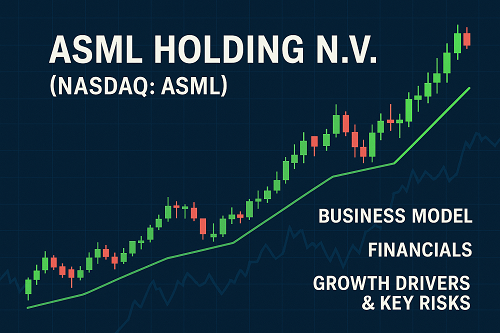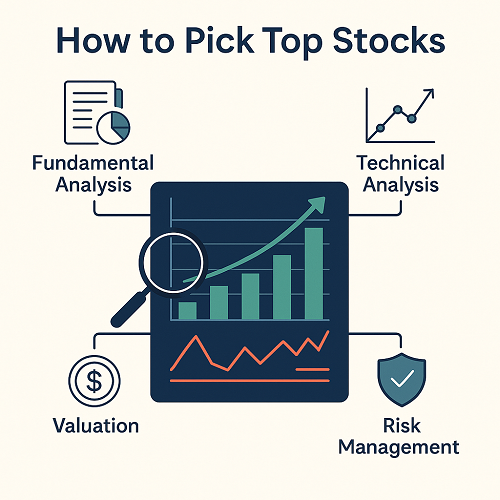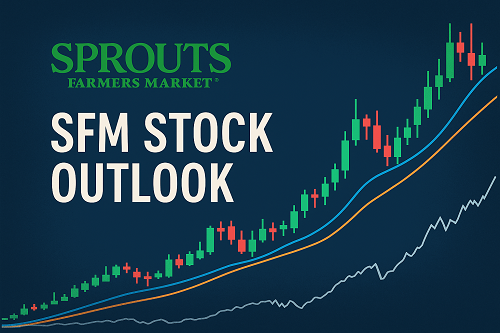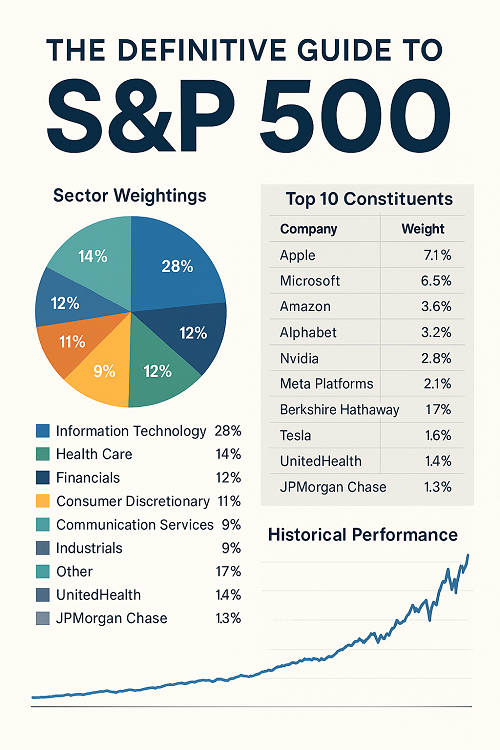Company Overview
ASML Holding N.V. (ticker: ASML) is a Netherlands-based company headquartered in Veldhoven, specializing in lithography systems used in semiconductor manufacturing. This company is listed on NASDAQ as ASML.
In brief, ASML’s machines enable chipmakers to “print” the complex circuitry on silicon wafers via optical processes.
Business Model
ASML generates revenue primarily from manufacturing and supplying high-end lithography systems (deep ultraviolet (DUV) and extreme ultraviolet (EUV)), plus service, spare parts and retrofit upgrades.
Key clients inclu
Because ASML’s machines are highly complex (often hundreds of millions of dollars per unit) and have long lead‐times, the business enjoys high barriers to entry and strong structural positioning.
What Makes ASML Unique
- It holds a near-monopoly in EUV lithography systems — the machines necessary for the most advanced nodes (e.g., <10 nm) in the semiconductor value chain.
- High customer switching costs: chipmakers invest deeply into process flows around ASML equipment.
- Strong backlog and long order-cycles give visibility into future periods.
- Integration across hardware, software and services, not just machine sales.
Industry Position & Competitive Advantage
Market Leadership
ASML is widely regarded as the leader in the semiconductor equipment industry, particularly for high-end lithography.
While there are competitors (e.g., Nikon Corporation, Canon Inc. in lithography equipment), none match ASML’s scale and technological leadership in EUV systems.
Competitive Moats
- Technological moat: The intellectual property, precision optics (via Zeiss), lasers, alignment systems and software required for EUV are extremely difficult to replicate.
- Customer relationships: ASML’s clients are the biggest chip-players globally, with multi-year commitments.
- High switching costs and long replacement cycles: Machine replacement intervals are long and integration is deep, which reduces churn.
- Geographic / systemic importance: As chips become more advanced (AI, high-performance computing, data centres), the lithography intensity rises — benefiting ASML disproportionately.
Market Context
The semiconductor industry is undergoing multiple structural shifts — rise of AI, generative AI, advanced logic and memory nodes, regional supply chain re-shoring — all of which point to increasing demand for advanced manufacturing equipment. ASML sits at the heart of that shift.
Key Growth Drivers & Trends
1. AI & Next-Generation Compute
The surge in artificial intelligence / machine learning has spurred demand for advanced semiconductors (logic, memory, packaging). ASML’s systems (especially EUV) are required for the most advanced nodes. For example, recent bookings surged amid AI spending.
2. Node Shrink & Lithography Intensity
As chipmakers move to smaller nodes (e.g., 3nm, 2nm, High-NA EUV), the number of lithography steps per wafer increases (“lithography intensity”). ASML benefits from this escalation.
3. Capital Expenditure Cycles & Backlog
Chipmakers have high capex cycles; ASML’s long lead times give it visibility and backlog strength. For example, recent order book of €5.4 billion in Q3 hit ahead of expectations.
4. Regional Supply-Chain Reshaping & On-shoring
Governments (US, EU, Asia) are pushing to bring advanced chip manufacturing closer. ASML is well-positioned to supply equipment to foundries globally, benefiting from localisation trends.
5. Services, Upgrades & Ecosystem
Beyond new machine sales, ASML gains recurring revenue from servicing, upgrade kits (DUV->EUV retrofits) and software — improving margin stability.
Financial Performance & Valuation Metrics
Financial Snapshot
- ASML’s revenue has grown significantly over the last decade (multiple folds) thanks to node transitions and global demand.
- According to MarketBeat, the consensus rating is a “Moderate Buy” with P/E in the high 30s, market cap around $400 billion as of late 2025.
Valuation Metrics
- P/E Ratio (TTM): in the ~35-40× range.
- Dividend Yield: modest (~0.6%) given the company is more growth-oriented.
- Analyst Price Targets: many in the ~$1,100-1,175 range, implying mid-teens percentage upside in the near term.
Valuation Commentary
Given ASML’s structural position, the premium multiple may be justified — if the growth narrative (AI, advanced nodes) holds. However, because the stock is already elevated, risk/reward may be tighter.
SWOT Analysis
Strengths
- Leading technological position in EUV lithography.
- High barriers to entry in the market segment.
- Strong backlog and global client base.
- Positioned in growth secular themes: AI, advanced semiconductors, node shrink.
Weaknesses
- High dependence on a few large customers/foundry players.
- Very high capital intensity in business (R&D, supply chain).
- Limited geographical diversification in some respects (heavy exposure to Asia/China).
Opportunities
- Increasing lithography intensity (more steps per chip wafer) as nodes shrink.
- Growing demand for advanced logic, memory and packaging.
- Expanding service, upgrade and retrofit revenue streams.
- Potential new markets (automotive, edge AI, 5G/6G infrastructure) requiring advanced chips.
Threats
- Geopolitical risk (export controls, trade restrictions, especially involving China).
- Supply-chain constraints (rare earths, optics, lasers). For example, ASML flagged rare earth export risks from China.
- Demand cyclicality / semiconductor industry downturns.
- Competitor disruption, or substitute technologies (though currently unlikely).
Key Risks to Be Aware Of
Geopolitical & Regulatory Risks
ASML is exposed to major export control regimes, especially concerning China. Any change in US/Netherlands/EU policy could materially affect ASML. For instance:
- China accounted for ~42% of ASML’s machine sales in Q3.
- Rare earth export controls from China may impact ASML’s supply chain.
Macro / Demand Cycle Risk
Even though the AI narrative is strong, semiconductor demand is cyclical. A slowdown in capex or chip demand (memory crash, logic oversupply) could dent ASML’s order volumes. For example, ASML had a soft Q1 bookings ahead of expectations.
Supply Chain & Technological Complexity
ASML’s machines are extremely complex, built with precision optics, lasers and dozens of subsystems. Any manufacturing bottleneck, quality issue or delay would have meaningfully negative impacts.
Overvaluation Risk
Given the premium valuation, if growth fails to meet expectations (e.g., slower node transitions, reduced AI capex), the stock could be vulnerable to a correction.
Customer Concentration
Heavy reliance on a small number of large chip-manufacturing entities (TSMC, Samsung, Intel) increases risk if any one of them cuts back capex or chooses alternative pathways.
Valuation Outlook & Analyst Sentiment
Analyst Sentiment
- Consensus range: Analysts are modestly bullish. MarketBeat notes a “Moderate Buy” rating for ASML.
- Some firms see upside into 2027 centered around High-NA EUV and lithography intensity, e.g., UBS Group AG upgrading ASML in that light.
- Price-targets span ~$1,100-1,175 range, implying ~10-15% upside from current levels (as of late 2025).
Valuation Outlook
On one hand, the secular tailwinds (AI, advanced chips) support a higher multiple. On the other, the premium is largely baked in — meaning much of the “good news” may already be reflected. Entry at current levels requires conviction in long-term growth beyond 2026 and tolerance for cyclicality.
Scenario Analysis
- Base Case: ASML grows EBITDA at mid-teens for next few years, maintains margin, multiple remains ~35× → moderate total return.
- Optimistic Case: High-NA EUV ramps prenode 2nm/1.8nm, orders accelerate, margins expand → multiple expands, significant upside.
- Downside Case: Geopolitical disruptions or industry cyclical downturns hit orders; multiple contracts → downside risk material.
Trading Considerations & Entry/Exit Strategies
For Traders
- Monitor the order backlog announcements and guidance revisions (these tend to move the stock).
- Pay attention to semiconductor capex cycles and foundry activity (TSMC, Samsung) as leading indicators.
- Watch geopolitical developments (US/Netherlands export controls, China rare-earths) which can cause sharp volatility.
For Long-Term Investors
- Given the premium valuation, consider staging entry rather than all-in at once.
- Set a target price (e.g., $1,100-1,200) or trailing stop to protect gains if growth disappoints.
- If you believe in the multi-year story (2027+), view entry as long-term hold with patience for next-gen node cycles.
Technical Considerations
- Since ASML is in the ~$1,000+ range (as of late 2025) the absolute moves are large; volatility is meaningful.
- Pullbacks may offer more favorable risk/reward, especially if supported by fundamentals.
Conclusion – Is ASML a Buy?
ASML is one of the most compelling companies in the semiconductor equipment space. It sits at the intersection of multiple secular trends — AI, advanced nodes, semiconductor on-shoring. Its near-monopoly in EUV lithography gives it a unique competitive position.
However, the premium valuation and the significant amount of good news already priced in mean that future returns may be more modest unless the company delivers above expectations (e.g., High-NA EUV ramp, new growth vectors). For investors/traders: if you have high conviction in the long-term structural story (5-10 years) and can handle volatility and geopolitical risk, ASML is a strong candidate. But for those seeking short-term upside with less risk, the margin for error is narrower.
My takeaway
- Long-term (5+ years): Yes — ASML is a strong “hold” if you believe the advanced semiconductor wave continues.
- Mid-term (2-3 years): More cautious — the upside exists, but somewhat constrained by current valuation.
- Short-term: Risk/reward is less favourable; you might want to wait for a pullback or clearer catalyst.





 XAUT-USD
XAUT-USD  AMD
AMD  MARA
MARA  SHOP
SHOP  BULL
BULL  CL=F
CL=F